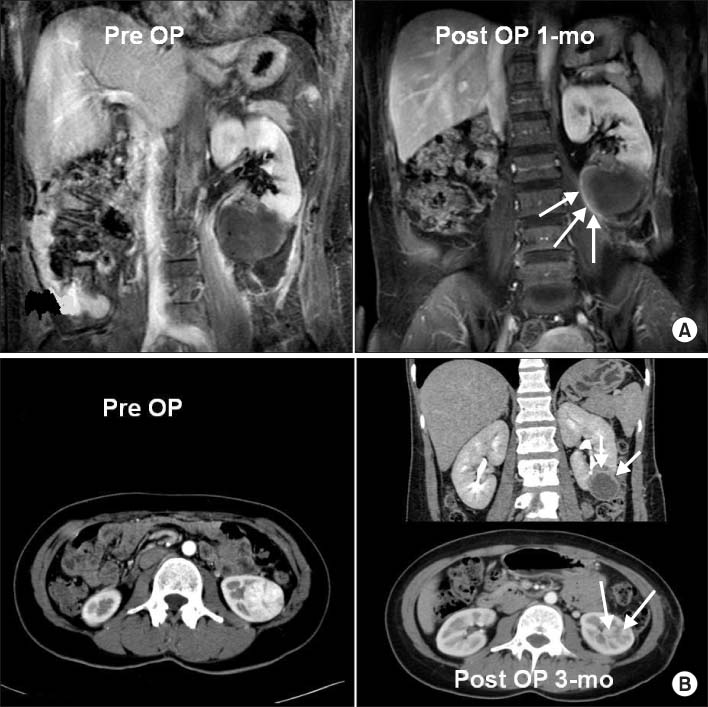Korean J Urol.
2010 Mar;51(3):171-177.
The Impact of Renal Tumor Size on the Efficacy of Laparoscopic Renal Cryoablation
- Affiliations
-
- 1Department of Urology, Korea University School of Medicine, Seoul, Korea. mdksh@korea.ac.kr
Abstract
- PURPOSE
We evaluated the impact of renal tumor size on the oncologic and surgical efficacy of laparoscopic renal cryosurgery (LRC) according to our intermediate-term experience in Korea. MATERIALS AND METHODS: From June 2005 to October 2008, we enrolled 37 patients who underwent LRC for 40 renal tumors. Patients were stratified into four groups according to renal tumor size. Patients who presented with a maximum tumor diameter (MTD) of at least 1 cm but less than 2 cm were assigned to Group 1, those with an MTD equal to or greater than 2 but less than 3 cm were assigned to Group 2, those with an MTD equal to or greater than 3 but less than 4 cm were assigned to Group 3, and those with an MTD equal to or greater than 4 cm were assigned to Group 4. Oncologic and clinical outcomes in each group were compared. RESULTS: The four groups showed no statistically significant differences in preoperative variables, including age, sex, body mass index, American Society of Anesthesiologists scores, baseline renal function and hemoglobin, and length of hospital stay. Regarding surgical aspects, however, operation time, estimated blood loss, and postoperative complications were significantly increased in patients with larger tumors. Three patients in Group 3 required postoperative transfusions, and 1 patient in Group 4 required conversion to open renal cryosurgery. During the mean follow-up period of 31.6 months, radiologic evidence of tumor recurrence was found in only 2 patients in Group 4. CONCLUSIONS: In this series, LRC for renal tumors smaller than 3 cm was conducted safely without radiologic evidence of tumor recurrence during intermediate-term follow-up. For tumors larger than 3 cm, however, the transfusion rate increased, and for renal tumors larger than 4 cm, the tumor recurrence rate increased significantly.
Keyword
MeSH Terms
Figure
Reference
-
1. Pantuck AJ, Zisman A, Belldegrun AS. The changing natural history of renal cell carcinoma. J Urol. 2001. 166:1611–1623.2. Jayson M, Sanders H. Increased incidence of serendipitously discovered renal cell carcinoma. Urology. 1998. 51:203–205.3. Fergany AF, Hafez KS, Novick AC. Long-term results of nephron sparing surgery for localized renal cellcarcinoma: 10-year followup. J Urol. 2000. 163:442–445.4. Patard JJ, Tazi H, Bensalah K, Rodriguez A, Vincendeau S, Rioux-Leclercq N, et al. The changing evolution of renal tumours: a single center experience over a two-decade period. Eur Urol. 2004. 45:490–493.5. Wille AH, Tüllmann M, Roigas J, Loening SA, Deger S. Laparoscopic partial nephrectomy in renal cell cancer--results and reproducibility by different surgeons in a high volume laparoscopic center. Eur Urol. 2006. 49:337–342.6. Allaf ME, Bhayani SB, Rogers C, Varkarakis I, Link RE, Inagaki T, et al. Laparoscopic partial nephrectomy: evaluation of long-term oncological outcome. J Urol. 2004. 172:871–873.7. Gill IS, Matin SF, Desai MM, Kaouk JH, Steinberg A, Mascha E, et al. Comparative analysis of laparoscopic versus open partial nephrectomy for renal tumors in 200 patients. J Urol. 2003. 170:64–68.8. Breining H, Helpap B, Minderjahn A, Lymberopoulos S. The parenchymal reaction of the kidney after local freezing. Urol Res. 1974. 2:29–31.9. Uchida M, Imaide Y, Sugimoto K, Uehara H, Watanabe H. Percutaneous cryosurgery for renal tumours. Br J Urol. 1995. 75:132–136.10. Lehman DS, Hruby GW, Phillips CK, McKiernan JM, Benson MC, Landman J. First prize (tie): laparoscopic renal cryoablation: efficacy and complications for larger renal masses. J Endourol. 2008. 22:1123–1127.11. Delworth MG, Pisters LL, Fornage BD, von Eschenbacj AC. Cryotherapy for renal cell carcinoma and angiomyolipoma. J Urol. 1996. 155:252–254.12. Gill IS, Novick AC, Soble JJ, Sung GT, Remer EM, Hale J, et al. Laparoscopic renal cryoablation: initial clinical series. Urology. 1998. 52:543–551.13. Rukstalis DB, Khorsandi M, Garcia FU, Hoenig DM, Cohen JK. Clinical experience with open renal cryoablation. Urology. 2001. 57:34–39.14. Gill IS, Novick AC, Meraney AM, Chen RN, Hobart MG, Sung GT, et al. Laparoscopic renal cryoablation in 32 patients. Urology. 2000. 56:748–753.15. Janzen NK, Perry KT, Han KR, Kristo B, Raman S, Said JW, et al. The effects of intentional cryoablation and radio frequency ablation of renal tissue involving the collecting system in a porcine model. J Urol. 2005. 173:1368–1374.16. Aron M, Gill IS. Renal tumor ablation. Curr Opin Urol. 2005. 15:298–305.17. Moinzadeh A, Spaliviero M, Gill IS. Cryotherapy of renal masses: intermediate-term follow-up. J Endourol. 2005. 19:654–657.18. Schwartz BF, Rewcastle JC, Powell T, Whelan C, Manny T Jr, Vestal JC. Cryoablation of small peripheral renal masses: a retrospective analysis. Urology. 2006. 68:1 Suppl. 14–18.19. Desai MM, Aron M, Gill IS. Laparoscopic partial nephrectomy versus laparoscopic cryoablation for the small renal tumor. Urology. 2005. 66:5 Suppl. 23–28.20. Weight CJ, Kaouk JH, Hegaty NJ, Remer EM, O'Malley CM, Lane BR, et al. Correlation of radiographic imaging and histopathology following cryoablation and radio frequency ablation for renal tumors. J Urol. 2008. 179:1277–1281.21. Wyler SF, Sulser T, Ruszat R, Weltzien B, Forster TH, Provenzano M, et al. Intermediate-term results of retroperitoneoscopy-assisted cryotherapy for small renal tumours using multiple ultrathin cryoprobes. Eur Urol. 2007. 51:971–979.22. Wright AD, Turk TM, Nagar MS, Phelan MW, Perry KT. Endophytic lesions: a predictor of failure in laparoscopic renal cryoablation. J Endourol. 2007. 21:1493–1496.23. Cestari A, Guazzoni G, dell'Acqua V, Nava L, Cardone G, Balconi G, et al. Laparoscopic cryoablation of solid renal masses: intermediate term follwup. J Urol. 2004. 172:1267–1270.24. Park MG, Kang SH, Cheon J. The initial experience with 3rd generation nephron-sparing cryoablation for renal tumor. Korean J Urol. 2007. 48:363–370.
- Full Text Links
- Actions
-
Cited
- CITED
-
- Close
- Share
- Similar articles
-
- The Initial Experience with 3rd Generation Nephron-sparing Cryoablation for Renal Tumor
- Antitumor Effect of in Situ Cryoablation with Systemic Immunotherapy on Murine Renal Cell Tumor
- Anti-tumor Immune Response after Cryoablation in Renal Cell Carcinoma Murine Model
- Follow-Up of Cryoablated Renal Cell Carcinoma with Residual Contrast Enhancement on CT and MRI
- Transient urine leakage following cryoablation: case report



